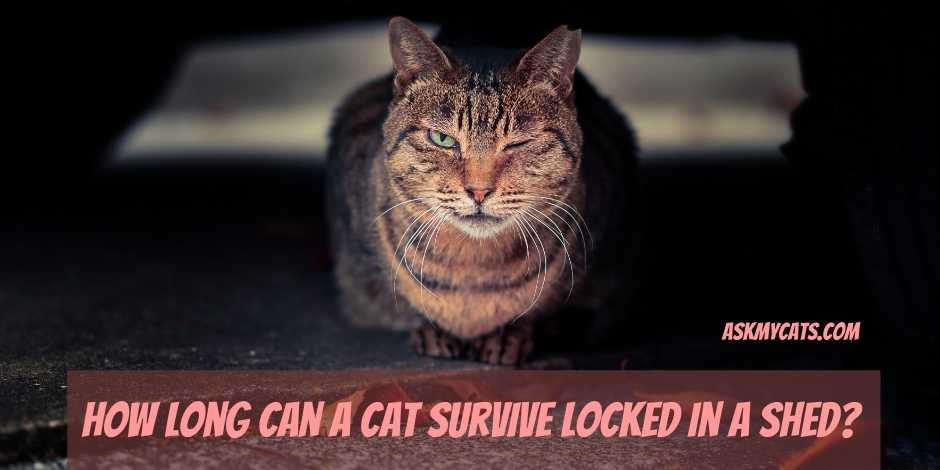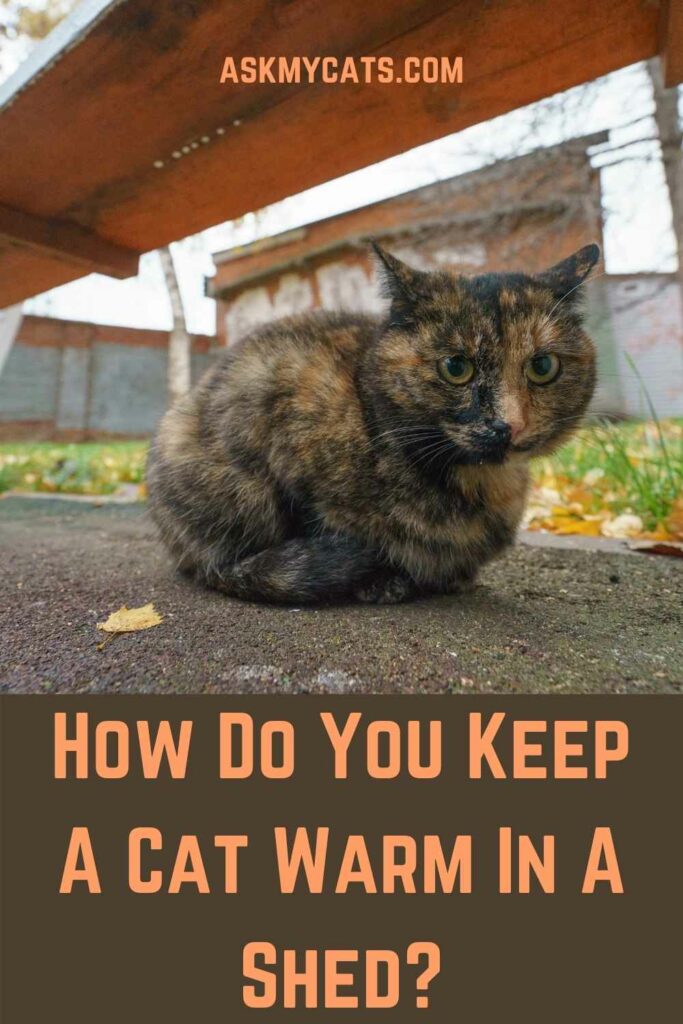Allowing your cat to live in a garden shed can be a suitable compromise if you have a family member who is allergic to cats, if you have too many cats and need extra room, or if your cat prefers to live outside.
Cats have an extremely robust mentality; as long as they have food and water, they can survive nearly anywhere for weeks, if not months, without going insane as we do.
In this post, I’ll show you how to create a timetable for how long your cat can live locked in a shed or garage, as well as some of the other places and reasons why cats disappear.


Give Your Cat the Perfect Day
Get the Free Ebook!
How Long Can a Cat Survive Trapped?
Cats can survive trapped for a fairly long period of time if they are provided with a continuous supply of food and water. If they are not provided with those basic necessities, they will die.
Any cat owner’s worst dread is their pet going missing. I’ve had that happen a few times for a few days, and it’s terrible not knowing where or what happened to my kitties.
Cats are inquisitive animals, and some are easily misled by overly nice neighbors who believe they are doing the right thing by feeding and fussing with them.
However, this frequently leads to cats wandering from their homes. Feeling at ease enough to examine places they shouldn’t, and in certain circumstances, spending too much time in other people’s houses.
If you’ve ever had a cat go missing for a few days, you’ll understand how the mind starts to speculate about all the horrible things that may have happened.
It’s not pleasant, but it’s the standard. After all, why would your cat not come back the next time they’re hungry?
The obvious places to search first are sheds, garages, porches, and any other areas they may have entered while the door was open and not exited before it closed.
With that in mind, food and water are unquestionably the most vital lifelines. So, let’s see how long they can last if they’re locked in a shed, garage, or anywhere else.
Must Read: Can I Keep My Cat In The Garage At Night?
How Long Can a Cat Survive Without Water?
When cats go missing, the first issue is a lack of water, because, after 1-2 days, they begin to dehydrate and become sick, and after 3 days, they are likely to die.
When a cat is confined in a shed or garage, the major concern is that there is unlikely to be drinking water.
When cats go missing in the neighborhood or in the outdoors, they are quite excellent at finding water sources and will be OK for weeks or even months.
Must Read: How Long Can A Cat Go Without Eating?
How Long Can a Missing Cat Go Without Food?
A healthy cat may go for several weeks without eating anything.
Obviously, the essential word here is ‘survive.’ They will be in significant danger of having irreparable health problems within a week or so.
It’s worth noting that just because a cat is bigger; it doesn’t mean it will live longer.
When cats are deprived of food or good nutrition, they are more likely to develop significant liver problems than thinner cats.
Find out more details about how long can cats go without food
Can A Cat Survive In A Shed?
If your cat has spent their whole life in a house, making the adjustment to a shed may be too difficult and stressful for them.

You should begin by acclimating your cat to being outside.
To do this, select a calm, dry day and monitor your cat’s first journey outside to guarantee a good first experience.
Allow your cat to explore at their own pace, and they will gradually become accustomed to the outside world, and you will be able to release them on their own.
If your cat reacts favorably to this and goes outside whenever possible, they will most likely love living in a shed.
If your cat is already a free roamer that enjoys being outside, that’s fantastic!
They’ll probably enjoy living outside because they’ll be able to explore whenever they choose.
Another factor to consider when considering whether or not to let your cat out is their age.
Kittens and elderly cats, in general, should never be kept in a shed.
Kittens require constant attention in case they get into mischief, and they are also more susceptible to temperature and other environmental changes.
As a result, leaving kittens alone in a shed might be risky.
Similarly, senior cats should not be moved to outside living, especially if they have never done it before, because they will find it much more difficult to adjust and accept the change.
Also, some senior cats may have motility of health issues, which means they wouldn’t have a chance in a fight and would be unable to cope with temperature changes.
If your cat is healthy and nimble, though, outdoor living may be ideal for them.
Must Read: How Long Can A Cat Go Without Water?
How Do You Keep A Cat Warm In A Shed?
If you’re creating a house for your cat in your shed, you’ll want to think about temperature control so that your cat is comfortable as the weather changes.

The type of material used to construct your shed is critical in ensuring that your cat keeps comfortable in its outside habitat, especially during the winter or if you reside in a cooler climate.
You may use a standard wooden shed or turn your garage into a new cat pad.
Avoid greenhouses, since they will get too hot in the summer and too chilly in the winter, making it difficult for your cat to be comfortable.
If you’re on a budget, you might also consider insulating your shed using polymer foam, foil insulation, or even bubble wrap.
For hotter summer days, make sure there are windows that can be opened or some sort of ventilation.
Getting the appropriate size shed may also make a big difference in how happy your cat is when he or she is outside.
Although your cat will be living in your yard with access to the entire outside world, they will still want a large enough a place for sleeping or when the weather is poor.
If you have many cats, this is an especially essential issue because cats are generally solitary creatures that want their own space, even if they appear to get along. Otherwise, they may grow agitated.
Stressed cats may exhibit a variety of behaviors, including spraying, snarling, and acting aggressively, or they may become ill and develop feline cystitis.
You should also think about the size of the entry because if it’s too small, dogs or other predators might sneak inside and cause havoc.
If you’re utilizing a standard garden shed, it’ll most likely have a standard door.
Install a cat flap instead of utilizing this as your cat’s entry point so that only cats may enter and exit the shelter.
If you’re worried about stray or feral cats taking advantage of your pet’s house, a microchip reader or one with collar control is a good idea.
This ensures that only your cats access and exit the shed, providing them with a much nicer and more private environment.
If you’re on a tight budget, you could also cut out cat-sized holes in one of the shed’s sides and tape the edges to smooth them out and avoid damage.
This is a more cost-effective option than acquiring a cat flap for your cat shed.
It’s also a good idea to assist shield your shed’s entrances from poor weather so that any rain or snow doesn’t make the inside moist.
One possibility is to build a ledge on the exterior of the shed to protect the doors and windows from the elements.
You may also connect a tarpaulin to the shed and spread it out like an awning over the entrance.
If you have the room, this is the preferable alternative since it provides better protection from severe weather while also allowing your cats to enjoy some fresh air without getting drenched on rainy days.
You can’t just put your cats in an empty shed; you’ll need to properly set up the interior to make it a place they’ll like.
Shelving should be installed on the interior of your cat shed.
Climbing is one of the cats’ natural behaviors, so providing them with plenty of opportunities to do so will keep them happy and engaged.
Shelving is also an excellent location for cats to perch and sleep since they prefer to have a secluded area up high where they can scan the room and feel comfortable.
To make it more appealing for your cats, add soothing objects like blankets, towels, and pet beds.
Also useful are cardboard boxes and other places to hide and curl up.
These things will also keep your cat warm on cooler days by providing greater insulation than if they lay on bare flooring.
Another wonderful feature is a feeding and watering station, so your cat has a specific area where they can get their food.
Even if the shed is outside, remember to keep their food and water fresh, or buy a cat water fountain and an automated feeder to ensure that your pet is well-fed all day.
Why Do Cats Like To Live Outdoors?
There are numerous reasons why cat owners would consider building a shed for their cats:

1. Population Explosion!
Your house may not be big enough for the number of cats you now own if your cat had a litter of kittens that you ended up keeping, or if you acquired a couple of too many stray cats.
Making a home for your cats outside in your shed might provide them more space and freedom, making them happier.
2. Stray Cats
Sometimes, especially if your cat was formerly a stray, they prefer to live outside rather than indoors.
If your cat prefers to be outside and spends more time outside than snuggled up on your lap or in their favorite hidey-hole, you might consider getting them an outdoor home to offer them a happier life.
3. Full Of Activities
Because there is so much to do in the wide outdoors, an outdoor cat is considerably less prone to grow overweight. Cats are more likely to spend time climbing, running, and exploring while they are out and about, which is good for their physical health.
It’s only natural as a pet owner to want to keep your pet as secure as possible when they’re out enjoying the sights and scents. Fortunately, there are a few things you can do to ensure that they are enjoying their best lives while being safe.
Frequently Asked Questions
How long do cats go missing for?
Within 24 hours, the majority of cats who go missing return home or are located. Starting a local search as soon as you notice your cat has disappeared is the best suggestion. Speak with your neighbors and look for your cat in garages and barns. If you don’t find your cat right away, post lost cat posters and notify local social media groups and missing pet websites.
Why do cats go missing?
Cats like roaming, albeit not necessarily far, and their inherent curiosity can occasionally take them on the wrong path. Cats go missing for a variety of reasons. There are, of course, a slew of others.
Do cats remember where they live?
Yes, cats are aware of their surroundings. Cats have a thousand times stronger sense of smell than humans, and they will rely on it as their primary mode of navigation to get home.
Final Words
Cats are tough creatures, and we frequently hear of cats that were thought to be lost returning home after days, if not weeks, of seemingly surviving on their own.
If they have access to water, the average cat can survive for one to two weeks without food. Even if they have enough water, it might take three to four days if they don’t get protein.
Feel free to leave your questions in the comments section below!
